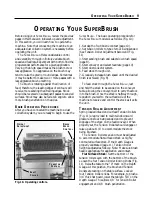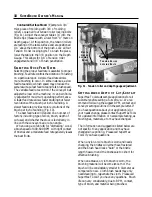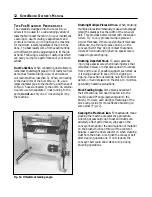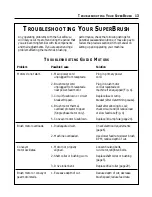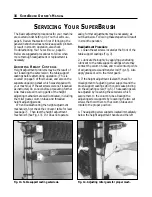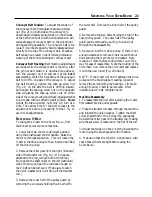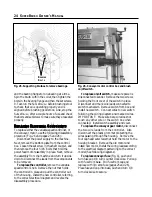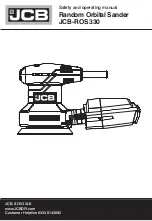
12 S
UPER
B
RUSH
O
WNER
’
S
M
ANUAL
T
IPS
F
OR
M
AXIMUM
P
ERFORMANCE
The versatility designed into the S
UPER
B
RUSH
allows it to be used for a wide-ranging variety of
tasks that will boost the return on your investment.
Learning to use its multiple adjustments and
controls will allow you to fine-tune the machine
for maximum results, regardless of the job to be
done. The best results come from experimenting
with different machine adjustments to fit the job
at hand. Following is a listing of useful tips which
can help you improve performance of your brush
sander.
Dust Collection.
When connecting dust collectors,
remember that straight pipe will not restrict airflow
as much as flexible tubing. Also, Ys and elbows
will restrict airflow less than Ts. When connecting
to the dual ports of the S
UPER
B
RUSH
36, use a
larger diameter pipe to the machine, and then split
to two 4˝ hoses connected to the ports. An alterna-
tive is to use two separate 4˝ lines running to the
ports;
do not
use only one 4˝ line and split it by
the machine.
Brushing Multiple Pieces At Once.
When brushing
multiple pieces simultaneously, make sure to stagger
(step) the pieces across the width of the conveyor
belt. This provides better contact with the tension
rollers. Try to only process multiple pieces of
similar thickness. If there is a significant thickness
difference, the thinner pieces can slip on the
conveyor belt if they do not contact the tension
rollers. When brushing high stock, special care is
needed to prevent tipping.
Brushing Imperfect Stock
. To avoid personal
injury, take special care when brushing stock that
is twisted, bowed, or otherwise varies in thickness
from end to end. If possible, support such stock as
it is being brushed to keep it from slipping or
tipping. Use extra roller stands, help from another
person, or hand pressure on the stock, to minimize
potentially hazardous situations.
Stock Feeding Angle.
Some pieces, because of
their dimensions, will need to be fed into the
machine at a 90° angle (perpendicular to the
brush). However, even a slight offset angle of the
stock can provide for more effective brushing on
some stock (Fig. 12).
Keeping the Machine Clean.
For best results, make
cleaning the machine a regular shop procedure.
Allowing excess build-up of dust and debris can
adversely affect performance, slippage on the
conveyor belt, and/or the accumulation of material
on the brush which can throw off the center of
balance. Leave the dust collector on when cleaning
dust from the brush. Also brush the conveyor belt
after cleaning operations. If not cleaned, the
conveyor belt could allow stock to slip during
brushing operations.
Fig. 12. Offset stock feeding angle.









